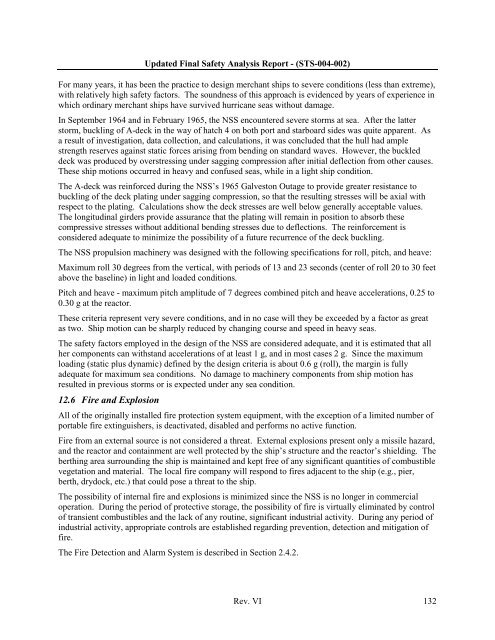10 CFR 50.71(e) - Maritime Administration - U.S. Department of ...
10 CFR 50.71(e) - Maritime Administration - U.S. Department of ...
10 CFR 50.71(e) - Maritime Administration - U.S. Department of ...
Create successful ePaper yourself
Turn your PDF publications into a flip-book with our unique Google optimized e-Paper software.
Updated Final Safety Analysis Report - (STS-004-002)For many years, it has been the practice to design merchant ships to severe conditions (less than extreme),with relatively high safety factors. The soundness <strong>of</strong> this approach is evidenced by years <strong>of</strong> experience inwhich ordinary merchant ships have survived hurricane seas without damage.In September 1964 and in February 1965, the NSS encountered severe storms at sea. After the latterstorm, buckling <strong>of</strong> A-deck in the way <strong>of</strong> hatch 4 on both port and starboard sides was quite apparent. Asa result <strong>of</strong> investigation, data collection, and calculations, it was concluded that the hull had amplestrength reserves against static forces arising from bending on standard waves. However, the buckleddeck was produced by overstressing under sagging compression after initial deflection from other causes.These ship motions occurred in heavy and confused seas, while in a light ship condition.The A-deck was reinforced during the NSS’s 1965 Galveston Outage to provide greater resistance tobuckling <strong>of</strong> the deck plating under sagging compression, so that the resulting stresses will be axial withrespect to the plating. Calculations show the deck stresses are well below generally acceptable values.The longitudinal girders provide assurance that the plating will remain in position to absorb thesecompressive stresses without additional bending stresses due to deflections. The reinforcement isconsidered adequate to minimize the possibility <strong>of</strong> a future recurrence <strong>of</strong> the deck buckling.The NSS propulsion machinery was designed with the following specifications for roll, pitch, and heave:Maximum roll 30 degrees from the vertical, with periods <strong>of</strong> 13 and 23 seconds (center <strong>of</strong> roll 20 to 30 feetabove the baseline) in light and loaded conditions.Pitch and heave - maximum pitch amplitude <strong>of</strong> 7 degrees combined pitch and heave accelerations, 0.25 to0.30 g at the reactor.These criteria represent very severe conditions, and in no case will they be exceeded by a factor as greatas two. Ship motion can be sharply reduced by changing course and speed in heavy seas.The safety factors employed in the design <strong>of</strong> the NSS are considered adequate, and it is estimated that allher components can withstand accelerations <strong>of</strong> at least 1 g, and in most cases 2 g. Since the maximumloading (static plus dynamic) defined by the design criteria is about 0.6 g (roll), the margin is fullyadequate for maximum sea conditions. No damage to machinery components from ship motion hasresulted in previous storms or is expected under any sea condition.12.6 Fire and ExplosionAll <strong>of</strong> the originally installed fire protection system equipment, with the exception <strong>of</strong> a limited number <strong>of</strong>portable fire extinguishers, is deactivated, disabled and performs no active function.Fire from an external source is not considered a threat. External explosions present only a missile hazard,and the reactor and containment are well protected by the ship’s structure and the reactor’s shielding. Theberthing area surrounding the ship is maintained and kept free <strong>of</strong> any significant quantities <strong>of</strong> combustiblevegetation and material. The local fire company will respond to fires adjacent to the ship (e.g., pier,berth, drydock, etc.) that could pose a threat to the ship.The possibility <strong>of</strong> internal fire and explosions is minimized since the NSS is no longer in commercialoperation. During the period <strong>of</strong> protective storage, the possibility <strong>of</strong> fire is virtually eliminated by control<strong>of</strong> transient combustibles and the lack <strong>of</strong> any routine, significant industrial activity. During any period <strong>of</strong>industrial activity, appropriate controls are established regarding prevention, detection and mitigation <strong>of</strong>fire.The Fire Detection and Alarm System is described in Section 2.4.2.Rev. VI 132
















